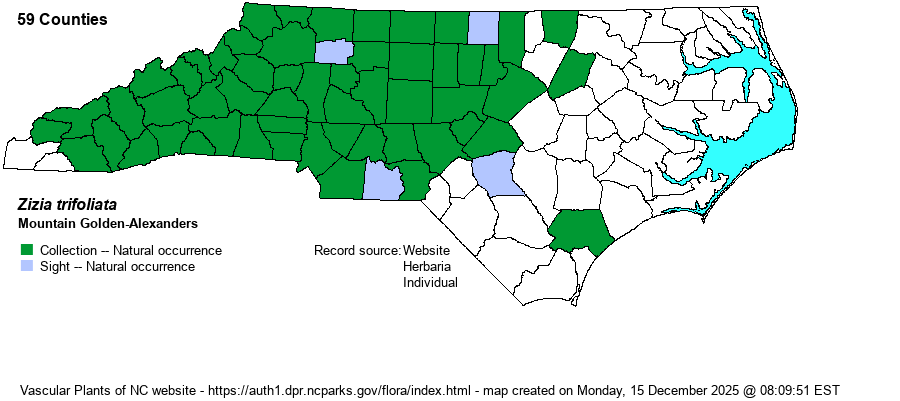| Author | (Michaux) Fernald | |
| Distribution | Throughout the Mountains and Piedmont, but found in the Coastal Plain only in a few very rich soil areas (Cumberland and Pender counties). Absent from the Sandhills proper.
This species has a rather small range, centered in the Southern Appalachians and adjacent Piedmont. It ranges from MD and WV south to northern FL and central AL. | |
| Abundance | Common in the Mountains, fairly common to common in the Piedmont; very rare in the Coastal Plain, where known from only a few counties. | |
| Habitat | This is a species of mostly mesic hardwood forests, often well into uplands and less so on rich slopes and bottomlands. It does grow on wooded borders and in openings, but seldom grows in full sun like Z. aurea may do. |
| Phenology | Blooms in April and May, and fruits in July and August. | |
| Identification | This is a typical-looking umbel in size, about 2 feet tall, with an erect stem and some branching in the upper portions. It has basal and stem leaves that are at least twice-pinnately divided into smaller leaflets, and all such leaves have strong and large teeth, only a few per centimeter of margin. In this species, some upper stem leaves can be reduced in size, and may be only once-divided into 3 leaflets. The umbels are fairly dense and bright golden-yellow like in other Zizia species. Separate this species first from Z. aurea by its relatively few and large teeth, often only 2-3/cm of margin, versus the numerous small teeth of the other, generally 5-10 teeth/cm. Then, separate it from Thaspium barbinode by having leaflets with a hyaline margin (use a hand lens), as opposed to leaf margins with some cilia in the Thaspium. Also, the umbels in Zizia are dense, with shorter and more rays than in Thaspium such that the umbellets in Zizia almost touch each other, whereas in Thaspium the umbellets are widely spread and not close to touching others. Note also that in Zizia species the central flower in each umbellet is sessile, whereas in Thaspium the central flower (as are all others) has a distinct pedicel; this may require a hand lens. | |
| Taxonomic Comments | None
| |
| Other Common Name(s) | Meadow Golden-Alexanders, Meadow Alexanders. Meadow Alexanders is used by some references, but this is a misnomer. This species does not grow in meadows! | |
| State Rank | S5 | |
| Global Rank | G5 | |
| State Status | | |
| US Status | | |
| USACE-agcp | FAC link |
| USACE-emp | FACU link |

